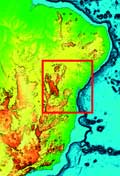 |
Episodic burial and exhumation in NE Brazil after opening of the South Atlantic |
Peter Japsen1, Johan M. Bonow1. Paul F. Green2, Peter R. Cobbold3, Dario Chiossi4, Ragnhild Lilletveit5, Luciano P. Magnavita6, and Augusto Pedreira7
1Geological Survey of Denmark and Greenland (GEUS), Øster Voldgade 10, 1350 Copenhagen, Denmark, pj@geus.dk; johan.bonow@telia.com
2Geotrack International, 37 Melville Road, Brunswick West, Victoria 3055, Australia, mail@geotrack.com.au
3Géosciences (UMR6118), CNRS et Université de Rennes1, 35042 Rennes, France, peter.cobbold@univ-rennes1.fr
4Statoil do Brasil, Praia de Botafoga 300, 22250-040 Rio de Janeiro, Brazil
5Statoil Angola Team, Grenseveien 21, 4035 Stavanger, Norway
6Petrobras, Av. República do Chile 330, Rio de Janeiro, 20031-170, Brazil
7Geological Survey of Brazil (CPRM), Av. Ulysses Guimaraes 2862, Salvador, 41213-000, Brazil
This webpage is a summary of: Japsen, P., Bonow, J.M., Green, P.F., Cobbold, P.R., Chiossi, D., Lilletveit, R., Magnavita, L.P., Pedreira, A.J., 2012. Episodic burial and exhumation history of NE Brazil after opening of the South Atlantic. Geol. Soc. Am. Bulletin., in press.
Post-rift burial and exhumation and formation of elevated peneplains
Landscapes along the Atlantic margin of NE Brazil are in many respects similar to those along other elevated, passive continental margins around the world, including West Greenland, Scandinavia and SE Australia (cf. Ollier & Pain, 1997; Lidmar-Bergström et al., 2000; Bonow et al., 2006a, b; Japsen et al., in press). Common characteristics are high-level, low-relief plateaus cut by deeply incised valleys, Mesozoic-Cenozoic rift systems along the coast where erosional unconformities commonly truncate a tilted, post-rift sequence, and a transition from continental to oceanic crust offshore. In NE Brazil the plateaus reach more than 1 km above sea level (asl) and they are in many places separated by escarpments from low-level, low-relief surfaces below 500 m asl (Figure 1).
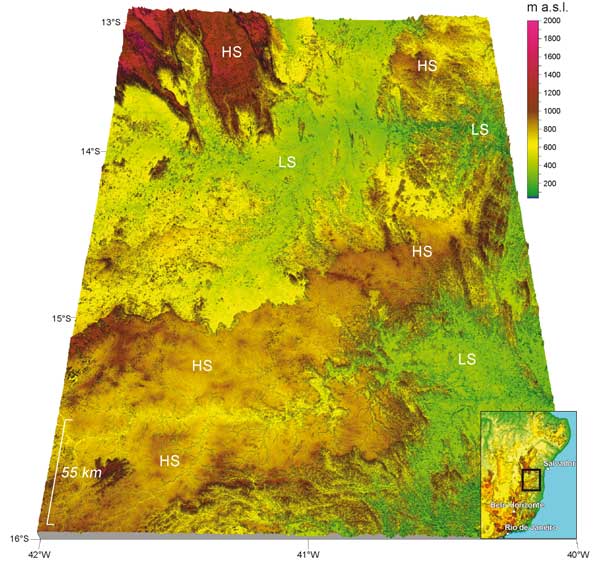
Figure 1. Altitude in NE Brazil between two plateaus (Chapada Diamantina in north and Planalto da Conquista in south) with interpretation of two peneplains, the Higher Surface and the Lower Surface, HS and LS. LS is between 300 to 400 m asl. and dips slightly eastwards. Sharp, erosional, winding escarpment separates LS from HS. HS is particularly well preserved on Planalto da Conquista (c. 900 m asl). Within the frame of the map, HS covers an area of c. 18,000 km2. HS is also clearly defined on Chapada Diamantina (c. 1200 m asl). The presence of elevated peneplains along passive, continental margins is an important constraint for any model of the post-rift development of such margins. Click here or on figure for enlargement.
It is a common assumption that elevated passive continental margins have remained high since rifting and breakup. Here, we show that the Atlantic margin of NE Brazil has under gone a more complex history. Our synthesis of geological data, landscape analysis, and paleothermal and paleoburial data reveals a four-stage history (Figures 2, 3).
- After Early Cretaceous breakup, the margin underwent burial beneath thick sedimentary cover;
- Uplift episodes in the Campanian and Eocene led to almost complete removal of these deposits;
- The resulting large-scale, low-relief erosion surface (peneplain), the Higher Surface, was deeply weathered and finally reburied at the Oligocene-Miocene transition;
- Miocene uplift and erosion produced a new, lower-level peneplain, the Lower Surface, by incision of the uplifted and re-exposed Paleogene peneplain.
Previous studies have identified aspects of this interpretation (e.g., Magnavita, 1994; Hamann et al., 1998; Cobbold et al., 2001; Peulvast et al., 2008), but we have defined the absolute timing and magnitude of discrete events of burial and exhumation that followed Early Cretaceous rifting and Eocene–Oligocene peneplanation. The results of our study provide considerably more detail about the timing, in particular because we did apatite fission-track analysis (AFTA) of rock samples from deep wells in the rift (e.g., Green et al., 2002).
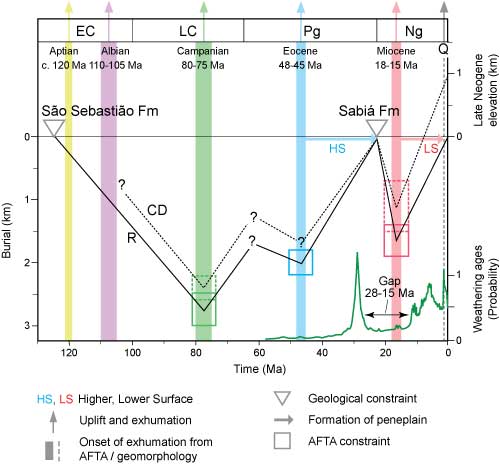
Figure 2. Burial and exhumation history of rocks now exposed on the Higher and Lower Surface within the study area. CD: Basement at the Higher Surface (HS) in Chapada Diamantina; dashed line and boxes. R: Rift sediment close to the Lower Surface (LS) in the Recôncavo Basin; full line and boxes. Green curve: relative probability of weathering ages on the Borborema Plateau (Guia Lima, 2008). The colored bands show the times of onset of cooling events defined from AFTA that we attribute to episodes of uplift and exhumation and their width indicates the uncertainty in the onset of cooling. Timing of the Quaternary event at c. 2 Ma based on geological evidence. The Albian event is recognizable only in samples east of the rift. EC: Early Cretaceous; LC: Late Cretaceous; Pg: Paleogene; Ng: Neogene, Q: Quaternary.
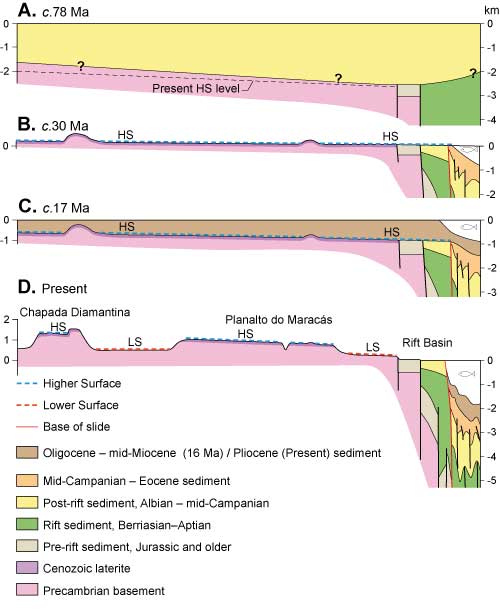
Figure 3. Burial and exhumation history along a profile across the Chapada Diamantina plateau and the rift basin. A: Campanian maximum burial of the Lower Cretaceous, syn-rift sequence below a Cretaceous cover. B: Final formation of the Higher Surface (HS) by erosion to base level as a peneplain with deep weathering profiles and laterites after Campanian and Eocene phases of uplift and erosion. C: Oligo-Miocene burial of the interior highlands and of the coastal zone. D: Reexposure of the HS and formation of the Lower Surface (LS) by river incision after Miocene uplift. Minor uplift in the Quaternary led to incision below the LS and to formation of the coastal plain.
Paleogene weathering profiles preserved under a protective cover until the present day
We suggest that a late sedimentary cover protected Paleogene weathering profiles until the present day. Vasconcelos & Carmo (2008) highlighted the major gaps in the record of Ar-Ar ages for lateritic weathering profiles, pre-70 Ma and 30 to 15 Ma. Reburial of the Higher Surface by an Oligo–Miocene cover provides a straightforward explanation for the gap in the weathering record between 30 and 15 Ma (see Figure 2), prior to the removal of this cover during the Miocene uplift event. The presence of an extensive Cretaceous cover prior to Campanian uplift and exhumation may similarly explain the lack of pre-70 Ma weathering ages.
Synchronous, trans-Atlantic uplift phases
Pronounced events of uplift and erosion in the Campanian and in the Eocene and Miocene have also been documented from western and south-western Africa (e.g., Walford et al., 2005; Turner et al., 2008). Evidence for several, broadly synchronous, trans-Atlantic uplift phases that post-date breakup (compare Figures 4B and 4C) is, however, presented here for the first time, although Harman et al. (1998) noted the symmetry between intracontinental deformation in Brazil and central Africa in the Late Cretaceous.
In agreement with this trans-Atlantic synchronicity, Burke & Gunnell (2008) showed that many aspects of the post-rift development of Africa are similar to those in NE Brazil. They presented both onshore and offshore evidence that southern Africa was low-lying by Santonian times (84 Ma), and that Afro-Arabia was dominated by a low-lying, low-relief landsurface mantled by deeply weathered rock by mid-Oligocene times. However, Burke & Gunnell (2008) failed to produce an integrated model of burial and exhumation capable of explaining young fission track ages in Africa (post-dating rifting by many Ma far into the continental interior).
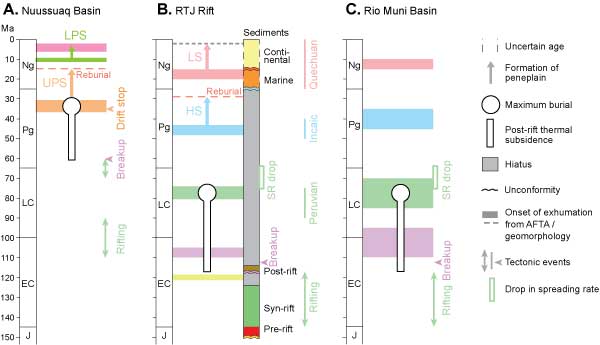
Figure 4. Comparison between timing of uplift events, formation of peneplains and tectonic episodes along margins in the Atlantic domain. A. Nuussuaq Basin (c. 70°N), West Greenland (Japsen et al., 2006). The Upper Planation Surface (UPS) defines the plateau whereas the Lower Planation Surface (LPS) is a system of elevated paleo-valleys (Bonow et al., 2006a,b). B. RTJ Rift (c. 12°S), NE Brazil (this study). Main phases of Andean orogeny: Peruvian, Incaic and Quechuan (e.g., Cobbold et al., 2001). C. Rio Muni Basin (c. 2°N), West Africa (Turner et al., 2008) (conjugate margin to NE Brazil). The colors of the vertical bands that indicate onset of uplift events and the interpreted correlation between events on the conjugate margins in NE Brazil and West Africa. The present-day landscapes in NE Brazil and West Greenland were formed millions of years after breakup when regional peneplains (HS and UPS, respectively) were uplifted and dissected during the Neogene. SR: spreading rate. See also caption to Figure 2. Click here or on image for enlargement.
Lateral changes in plate motion and vertical movements along passive continental margins
The Campanian, Eocene and Miocene uplift phases in NE Brazil also coincide with three main phases of Andean orogeny which occurred during periods of relatively rapid convergence at the Andean margin of South America (e.g., Cobbold et al., 2001; 2007), Peruvian (90–75 Ma), Incaic (50–40 Ma), and Quechuan (25–0 Ma). The Campanian uplift in NE Brazil event coincides with rapid convergence on the Andean margin of South America and with a decline in the Atlantic spreading rate (Torsvik et al., 2009). Consequently, we suggest that both vertical movements and lateral changes in the motion of the plates have a common cause, which is lateral resistance to plate motion.
Because the uplift phases in NE Brazil and SW Africa are common to the margins of two diverging plates, we also suggest that the driving forces can transmit across the spreading axis, probably at great depth, e.g., in the asthenosphere.
The interaction between the differential opening of the Central and South Atlantic Oceans and Late Cretaceous continental tectonics in Brazil and central Africa also agrees with previous observations (e.g., Harman et al., 1998). Similarly, a phase of uplift and erosion at the Eocene–Oligocene transition (c. 35 Ma), that affected margins around the North Atlantic (Green & Duddy, 2010), correlates with a major plate reorganization there (Gaina et al., 2009).
References
-
Bonow, J.M., Japsen, P., Lidmar-Bergström, K., Chalmers, J.A., and Pedersen, A.K., 2006a, Cenozoic uplift of Nuussuaq and Disko, West Greenland - elevated erosion surfaces as uplift markers of a passive margin: Geomorphology, 80, 325-337.
-
Bonow, J.M., Lidmar-Bergström, K., and Japsen, P., 2006b, Paleosurfaces in central West Greenland as reference for identification of tectonic movements and estimation of erosion: Global Planet. Change, 50, 161-183.
-
Burke, K., and Gunnell, Y., 2008, The African Erosion Surface: A Continental-Scale Synthesis of Geomorphology, Tectonics, and Environmental Change over the Past 180 Million Years: Boulder, Colorado, Geol. Soc. Am., 66 pp.
-
Cobbold, P.R., Meisling, K.E., and Mount, V.S., 2001, Reactivation of an obliquely rifted margin, Campos and Santos basins, southeastern Brazil: AAPG Bulletin, 85, 1925-1944.
-
Cobbold, P.R., Rossello, E.A., Roperch, P., Arriagada, C., Gómez, L.A., and Lima, C., 2007, Distribution, timing, and causes of Andean deformation across South America, in Ries, A.C. et al., eds., Special Publications, 272, London, Geol. Soc., 583-592.
-
Gaina, C., Gernigon, L., and Ball, P., 2009, Paleocene - Recent plate boundaries in the NE Atlantic and the formation of the Jan Mayen microcontinent: J. Geol. Soc., London, 166, 601-616.
-
Green, P.F. and Duddy, I., 2010, Synchronous exhumation events around the Arctic including examples from Barents Sea and Alaska North Slope, in Vining, B.A., and Pickering, S.C., eds., Petroleum Geology: From Mature Basins to New Frontiers – Proceedings of the 7th Petroleum Geology Conference, London, Geol. Soc., 633-644.
-
Green, P.F., Duddy, I.R., and Hegarty, K.A., 2002, Quantifying exhumation from apatite fission-track analysis and vitrinite reflectance data: precision, accuracy and latest results from the Atlantic margin of NW Europe, in Doré, A.G. et al., eds., Spec. Publ., 196, London, Geol. Soc., 331-354.
-
Guia Lima, M.D., 2008, A História do Intemperismo na Província Borborema Oriental, Nordeste do Brasil: Implicações Paleoclimáticas e Tectônicas [PhD thesis]: Natal, Universidade Federal do Rio Grande do Norte, 251 pp.
-
Harman, R., Gallagher, K., Brown, R., Raza, A., and Bizzi, L., 1998, Accelerated denudation and tectonic/geomorphic reactivation of the cratons of northeastern Brazil during the Late Cretaceous: JGR-Solid Earth, 103, 27091-27105.
-
Japsen, P., Bonow, J.M., Green, P.F., Chalmers, J.A., and Lidmar-Bergström, K., 2006, Elevated, passive continental margins: Long-term highs or Neogene uplifts? New evidence from West Greenland: Earth Planet. Sci. Lett., 248, 315-324.
-
Japsen, P., Chalmers, J.A., Green, P.F., and Bonow, J.M., 2012, Elevated, passive continental margins: Not rift shoulders but expressions of episodic, post-rift burial and exhumation: Global Planet. Change, (in press).
-
Lidmar-Bergström, K., Ollier, C.D., and Sulebak, J.C., 2000, Landforms and uplift history of southern Norway: Global Planet. Change, 24, 211-231.
-
Magnavita, L.P., Davison, I., and Kusznir, N.J., 1994, Rifting, erosion, and uplift history of the Recôncavo-Tucano-Jatobá Rift, northeast Brazil: Tectonics, 13, 367-388.
-
Ollier, C.D., and Pain, C.F., 1997, Equating the basal unconformity with the paleoplain: A model for passive margins: Geomorphology, 19, 1-15.
-
Peulvast, J.P., Sales, V.C., Bétard, F., and Gunnell, Y., 2008, Low post-Cenomanian denudation depths across the Brazilian Northeast: Implications for long-term landscape evolution at a transform continental margin: Global Planet. Change, 62, 39-60.
-
Torsvik, T.H., Rousse, S., Labails, C., and Smethurst, M.A., 2009, A new scheme for the opening of the South Atlantic Ocean and the dissection of an Aptian salt basin: Geophys. J. Int., 177, 1315-1333.
-
Turner, J.P., Green, P.F., Holford, S.P., and Lawrence, S.R., 2008, Thermal history of the Rio Muni (West Africa)-NE Brazil margins during continental breakup: Earth Planet. Sci. Lett., 270, 354-367.
-
Vasconcelos, P., and Carmo, I.D., 2008, Calibrating denudation chronology through 40Ar/39Ar weathering geochronology, 33rd International Geological Conference: Oslo, p. 1.
-
Walford, H.L., White, N.J., and Sydow, J.C., 2005, Solid sediment load history of the Zambezi Delta: Earth Planet. Sci. Lett., 238, 49-63.
last updated 23rd
April, 2012 |
